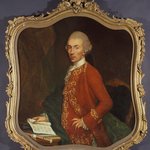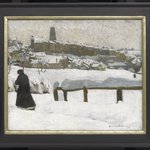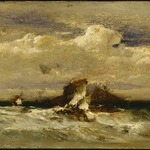Did people pray to this?

Yes. This small triptych was intended for personal devotion in a private chapel or a corner of the home (as opposed to communal devotion in a Church or during public ritual.) It would originally have stood on its base (rather than being hung on the wall). The fervor with which individual Christians practiced their faith often took a toll on the objects that aided their devotion. Owners might repeatedly kiss and caress them, wearing away details carved into the surface and obliterating the features of holy figures. In this triptych, some of the paint is abraded and damaged, specifically the robes of the Madonna and of the saint to her left and the image of the Redeemer above.
A late-Medieval or early-Renaissance viewer would have imbued the images with spiritual power. The Christian symbolism, the frontal orientation and careful rendering of the holy subjects, and the precious materials were all intended to prompt spiritual meditation by making the object of devotion tangible.
"A clever approach to representing depth, before the invention of perspective." When was perspective invented? And by whom?

In 1434/35, Leon Battista Alberti published the first major Renaissance treatise on perspective by Alberti based on ideas already known since antiquity. At the same time, the great Florentine architect Brunelleschi (as in the dome of the cathedral) was experimenting in one point perspective. Prior to this, there were certainly attempts to create perspective but there was no scientific basis. It really was just artist trying to recreate nature. After Alberti it becomes scientific perspective as opposed to the earlier illusion of perspective.
Gothic art drew a lot of inspiration from Byzantine tile work, where figures can't appear to be behind each other, so they are stacked. Here the artist is stacking the figures to depict how a crowd of people might look.
Any egg tempera paintings?
Oh, let me look into that! Are you an artist? I have found that artists are often interested in materials.
Sort of! I just came from the library and saw some really amazing egg tempera paintings.
Many of the religious paintings in the Beaux-Arts Court, where you are, were painted with tempera. In the Renaissance-era, tempera was mixed with egg and that material practice has been used actually since ancient Egypt through the Renaissance until it was eventually replaced with oil paints.
Oh! Awesome! Why was it replaced?
Mainly because the effects that can be achieved with oil paints are much greater than with tempera. Artists could achieve more color, depth and contrasts with oil. Oil takes much longer to dry allowing the artist to continually make changes and add layers of color. The surface is often brighter.
Is Mary supposed to be topless and this was censored?

I'm glad to see you're looking so closely at Maso di Banco's triptych. Mary is not meant to be topless, it appears as though her shirt is a sort of coral or salmon color, and the typical blue robe she is often seen wearing is draped around her. On occasion she is presented breast feeding (Madonna Lactans) the Christ Child which was seen as a sign of her compassion and does not seem to have caused offense.
This left-hand panel is separated into three 'scenes' in a vertical manner: the top scene shows the Annunciation, when the angel Gabriel came to tell Mary she would conceive Jesus. The middle scene shows the shepherds, who were told about the coming of Jesus by angels, and who visited Jesus, Mary and Joseph after Jesus' birth. And the bottom scene, that you sent a photo of, is a nativity scene. Jesus is in the manger, the Virgin Mary is relaxed next to the baby, and Joseph sits at the front, all three figures have halos above their heads. This way of showing a story in various scenes on top of each other is called a 'stacked composition' and was popular to help tell stories.
Thank you!
How did they achieve a blue this vivid?

The beautiful blue of Madonna's cloak was made using the pigment ultramarine, derived from the precious blue mineral lapis lazuli. Found exclusively in the mountains of northern Afghanistan, lapis had been laboriously mined by the Egyptians, Greeks, and Romans from early antiquity. Towards the end of the Middle Ages, it began to be ground into powder and made into ultramarine, quickly becoming the finest and most expensive pigment of them all.
Why is Mary often depicted in blue?
Mary is often depicted with a blue mantle because blue was associated with the sky and Mary was being portrayed as the Queen in Heaven. Additionally, blue pigments were very expensive and were often reserved for the holiest figures in a given scene.
Religious iconography had to be consistent so that illiterate worshipers could identify key figures. The blue mantle is also a useful visual device used throughout the history of Christianity!
Thanks!
Did both purple and blue signify royalty?
If only the wealthy could afford a certain pigment, it became associated with those in power. Purple pigment has also at various points in history been difficult to obtain.
The popularity of a particular color depended on location and time period, since trade and development of new pigments play a key role in what is expensive! Blue was associated with royalty when pigment was only being made from lapis lazuli, a difficult to obtain stone. When synthetic blue pigment became available in Europe, it was no longer associated with wealth and royalty, as it was much easier to come by!
Woah, that's crazy. Thanks for sharing all your wisdom.
Who are all the people in this triptych?
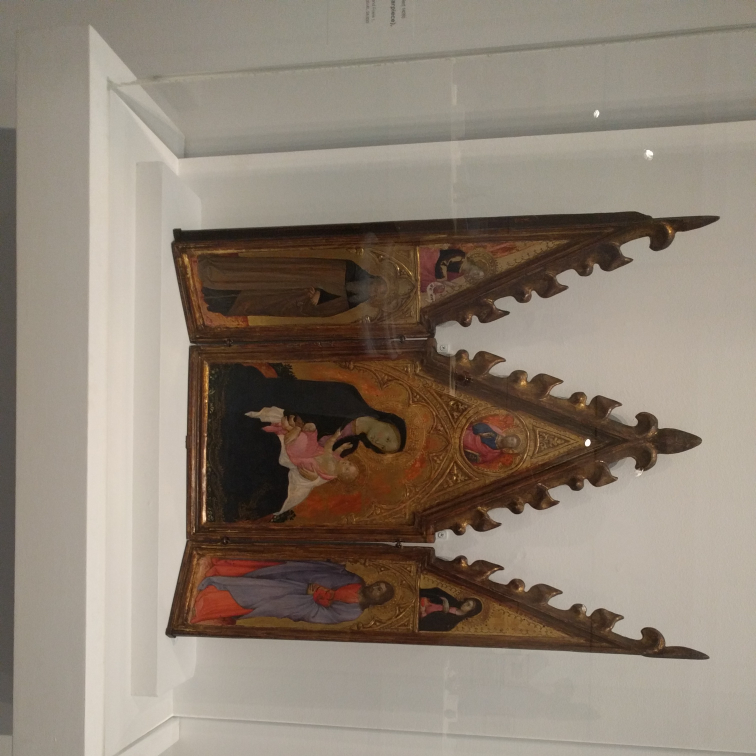
On the left you have the Angel Annunciate above and St. Anthony Abbot below. In the center Christ the Redeemer and Madonna of Humility with christ child. On the right the Virgin Annunciate and St. James Major.
Thanks
Who is St. Anthony Abbott? What does he symbolize in this painting?

Anthony Abbot was an important 3rd century saint, who is traditionally considered to be the first ever monk. He renounced his worldly goods and retreated to the Egyptian desert. He attracted other men to the desert, eventually forming the first Christian monastic community. He is identified by his staff which evokes his wanderings through the desert, as well as his bell and habit, evoking his legacy as the founder of monastic orders.
This portable altarpiece was an object for individual worship and was likely used in the home or a private chapel. The saints represented may have been chosen by the owner and allowed them to engage quietly on an intimate, emotional level.
Thank you very much!
I am looking at the paintings of the Virgin Mary. Do you know if lapis lazuli was used in any of the particular paintings?
Unfortunately none of these Virgin Mary paintings have been tested to determine the makeup of the pigments. However, the deep blue of the Virgin Mary's cloak was painted with costly lapis lazuli pigment in paintings of the time, so it's definitely a possibility.
Even if the ultramarine pigment is not present, the shade itself is still symbolic and is meant a reference to the stone.
Is it called the "dormition” of the Virgin? The position that the she's in on the lower left panel?
"Dormition of the Virgin" refers to a scene of her death often shown surrounded by disciples. In this lower left scene she is reclining because she has just given birth.
Note the infant Christ beside her and the cow behind him showing that they are in the manger.
Thank you
Tell me more.

This altar piece shows the Madonna and child as a triptych with scenes from Christ's birth and death as well. A small altarpiece like this would have been the focus of private devotion likely in the home of a wealthy family.
This is the only surviving triptych by this artist, Maso di Banco, and although it isn't dated or signed, many art historians have attributed it to the artist based on the distinctive stylistic features!
I was surprised by this depiction of the stable birth. I haven’t seen that in iconography that I am familiar with. I study Marian portrayals and found this interesting.

I have seen a few depictions of the birth in the stable, even ones that look very similar to this one. My understanding is that they were more common earlier in European history in the Medieval/Gothic period.
Later, images of Christ's birth amongst the animals start to look more like Van Der Goes's well-know depiction in what is known as the Portinari Altarpiece.
Thank you
About the altarpieces, were they commissioned by a church, or as a personal testament of faith?
Both! Larger works were typically for church settings while smaller works can typically be expected to have been for personal devotion.
We believe, for example, that Nardo di Cione's altarpiece was meant for a small chapel within the famous Duomo in Florence.
But something like the small portraits of the Madonna and Child in Infinite Blue would have been for a wealthy homeowner for use as a focus of personal devotion.
What's happening here?
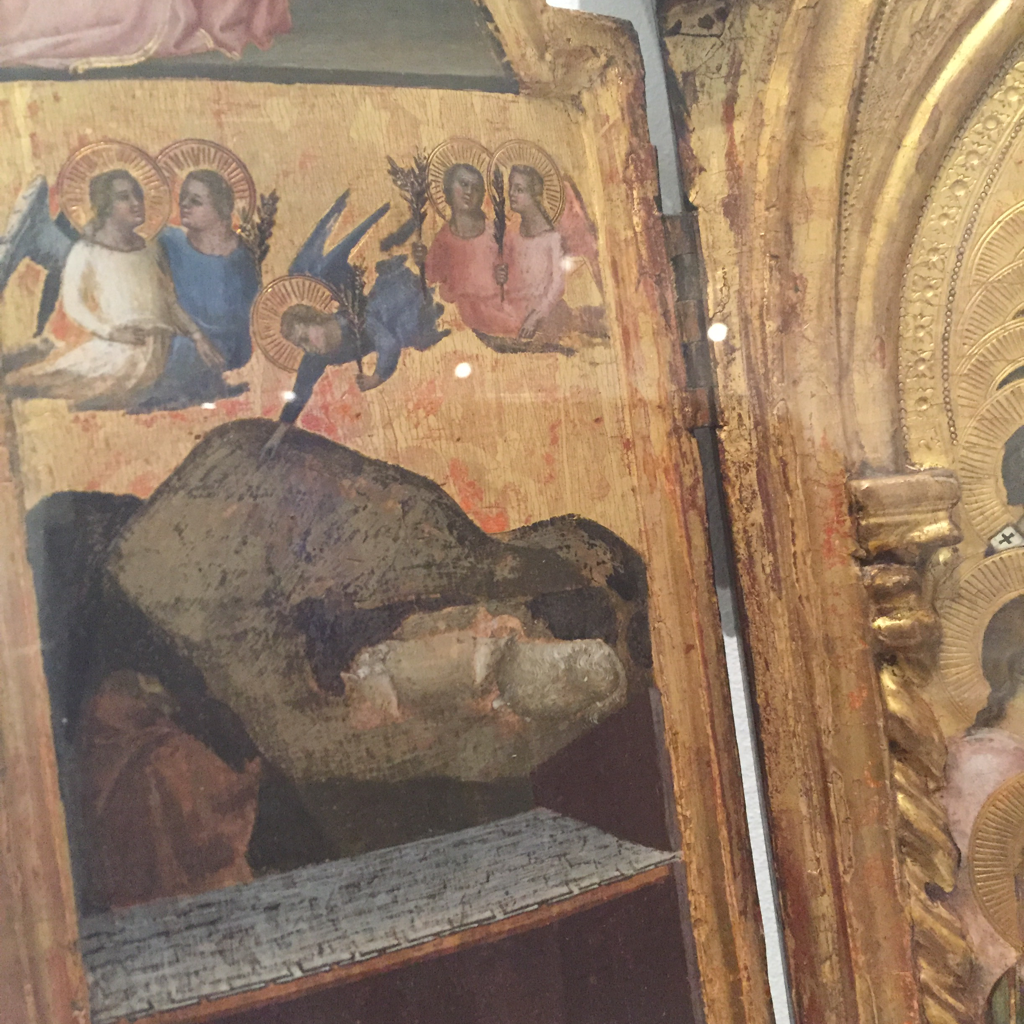
Great close looking! This is another section of the manger you see depicted with Mary and the newborn Jesus below. Here, Joseph is visited by angels and is beside some sheep.
We were wondering why some other figurines apart from St. Mary have blue garments as well. Can you explain it to us?

The Virgin's blue garments, as you may know, communicates her status akin to royalty because blue pigment, especially ultramarine blue paint, was quite expensive in the Medieval and Renaissance periods. It could communicate wealth in general.
In this particular altarpiece, it also also worth mentioning that there are two different types of blue paint used. The dark blue, like on Mary's cloak is likely ultramarine. The lighter blue seen on garments in the wings is made from another material, possibly cobalt.
Is the figure at the top in the center panel God?
Close! That is an image of Christ in heaven! Likely a reference to the Ascension of Jesus when he took his seat at the right hand of God.
In the top right corner Mary is holding a paper, what is it?
It’s meant to be a Bible or prayer book! This is a depiction of the Annunciation, when the angel Gabriel appeared to Mary during her private devotions to tell her she was pregnant with the son of God.
Thank you!
Who are the people surrounding Mary on the center panel?
Those are various Saints. Only about 6 can be identified but there are 20 total; you can tell by their halos! Going from left to right from the bottom up there's Mary Magdalene, Catherine of Alexandria, James the Great, John the Baptist, Peter, and Paul.
It looks like there's some kind of animal at the bottom of the cross... what is that? And can you explain more about the representation?

What you're seeing is actually a skull, representing the skull of Adam. This is a reference to the folk belief that Jesus was crucified over Adam's grave. Do you see the trickle of blood running down the cross? It represents the belief that even Adam was redeemed through Jesus's sacrifice.
Can you tell me about this artist please?
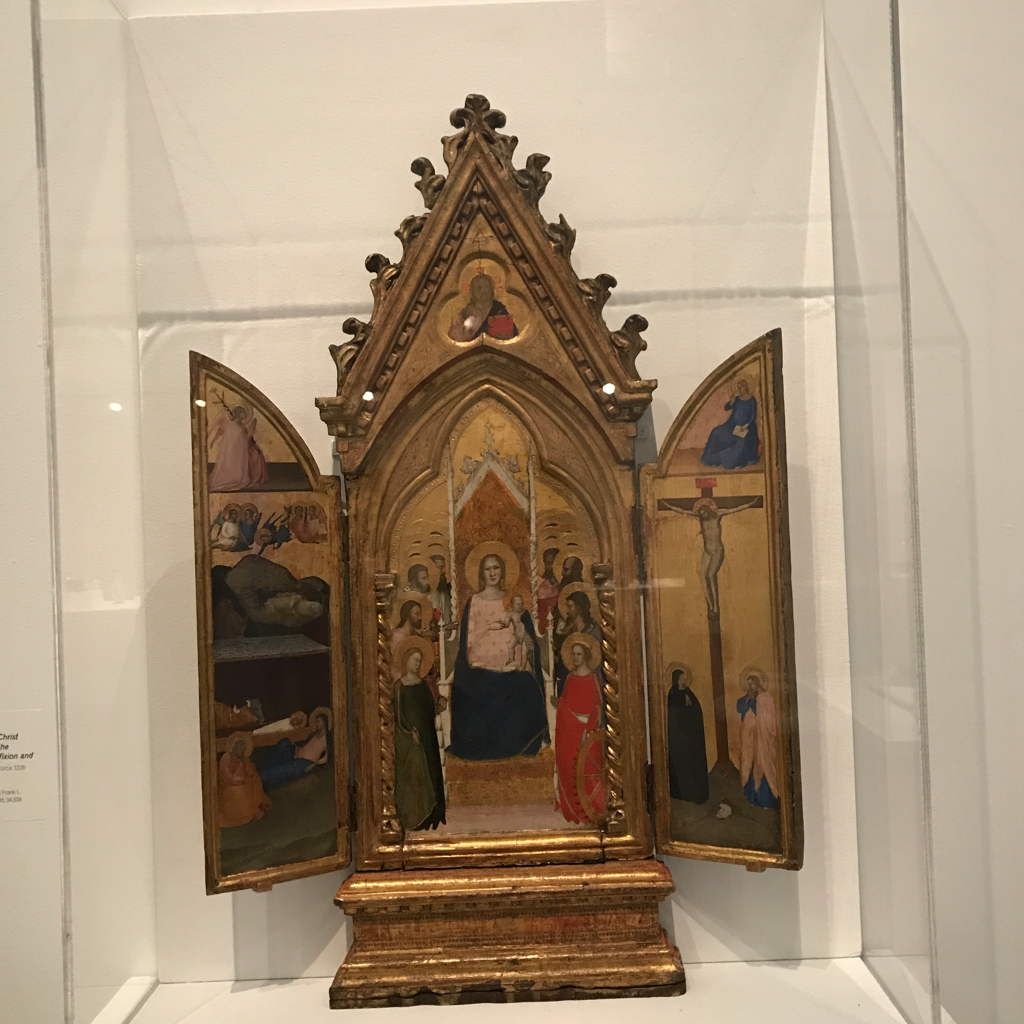
Sure! Maso di Banco was one of the great figures of 14th century Italian painting. His work is heavily influenced by that of the well-known Giotto, though it's unlikely that Maso di Banco actually trained with him.
Scholars do believe that Maso di Banco trained with Bernardo Daddi who did train with Giotto. Generally, this artist's life and career is poorly documented, but many paintings have been attributed to him based on their distinctive stylistic characteristics.
Very nice, thank you so much.
Who are the figures on the right below the cross?
Those are the Virgin and St John the Baptist at Christ's crucifixion.























